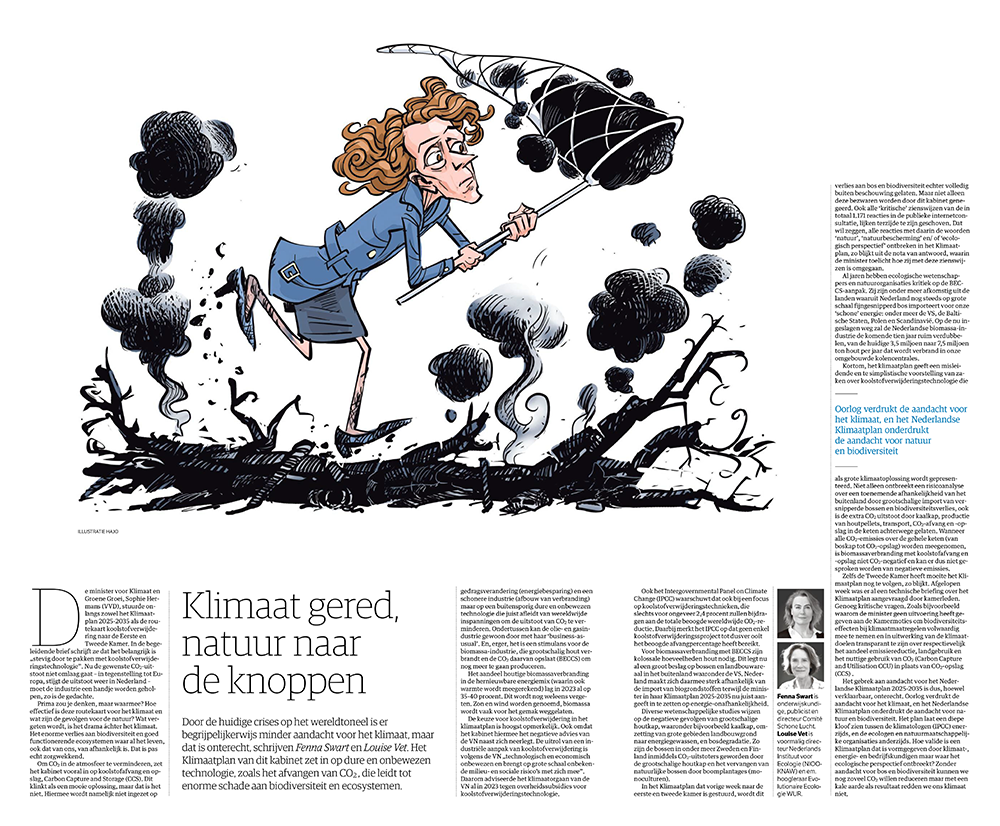Climate saved, nature ruined
The current crises on the world stage have understandably led to less attention for climate, but that is unjustified, write Fenna Swart and Louise Vet. The Climate Plan of this cabinet focuses on expensive and unproven technology, such as capturing CO2, which leads to enormous damage to biodiversity and ecosystems.

The Minister for Climate and Green Growth, Sophie Hermans (VVD), recently sent both the Climate Plan 2025-2035 and the carbon removal roadmap to the Senate and House of Representatives. In the accompanying letter, she writes that it is important to “continue firmly with carbon removal technology”. Now that the desired CO2 emissions are not decreasing – unlike in Europe, emissions are rising again in the Netherlands – the industry needs a helping hand, so the idea goes.
Great, you might think, but with what? How effective is this roadmap for the climate and what are the consequences for nature? What is forgotten is the drama behind the climate. The enormous loss of biodiversity and well-functioning ecosystems on which all life, including ours, depends. That is really worrying.

Fenna Swart is an educationalist, publicist and director of the Clean Air Committee.

Louise Vet is former director of the Netherlands Institute of Ecology (NIOO-KNAW) and em. professor of Evolutionary Ecology at WUR.
In order to reduce CO2 in the atmosphere, the government is mainly focusing on carbon capture and storage (CCS). This sounds like a nice solution, but it is not. This does not focus on behavioral change (energy saving) and a cleaner industry (phasing out combustion), but on an excessively expensive and unproven technology that actually distracts from global efforts to reduce CO2 emissions. In the meantime, the oil and gas industry can simply continue with its ‘business-as-usual’. And, worse, it is an incentive for the biomass industry, which burns wood on a large scale and stores the CO 2 from it (BECCS), to produce even more.
The share of woody biomass combustion in the renewable energy mix (which also includes heat) was already 35-40 percent in 2023. This is sometimes forgotten. Sun and wind are mentioned, biomass is often conveniently omitted.
Technologically unproven
The choice for carbon removal in the climate plan is highly remarkable. Also because the cabinet is ignoring the negative advice of the UN. According to the UN, the rollout of an industrial approach to carbon removal is “technologically and economically unproven and entails unknown environmental and social risks on a large scale”. That is why the UN climate body already advised against government subsidies for carbon removal technology in 2023.
The Intergovernmental Panel on Climate Change (IPCC) also warns that even with a focus on carbon removal technologies, they will only contribute about 2.4 percent of the total targeted global CO2 reduction. The IPCC also notes that no carbon removal project has ever achieved the targeted capture percentage.
Biomass combustion with BECCS requires colossal amounts of wood. This already places a heavy burden on forests and agricultural land abroad, including in the US. The Netherlands is thus making itself highly dependent on the import of bio-based raw materials, while the minister in her Climate Plan 2025-2035 now indicates that she is focusing on energy independence.
Several scientific studies point to the negative effects of large-scale logging, including clear-cutting, conversion of large areas of agricultural land to energy crops, and forest degradation. For example, forests in Sweden and Finland have now become CO2 emitters due to large-scale logging and the replacement of natural forests by tree plantations (monocultures).
In the Climate Plan that was sent to the first and second chambers last week, this loss of forest and biodiversity is completely ignored. But it is not only these objections that are ignored by this cabinet. All ‘critical’ views of the total of 1,171 responses in the public internet consultation also seem to have been pushed aside. That is to say, all responses containing the words ‘nature’, ‘nature conservation’ and/or ‘ecological perspective’ are missing from the Climate Plan, as is apparent from the explanatory memorandum, in which the minister explains how she dealt with these views.
Finely chopped forest
For years, ecological scientists and nature organisations have criticised the BECCS approach. They come from countries from which the Netherlands still imports finely shredded forest on a large scale for our ‘clean’ energy: including the US, the Baltic States, Poland and Scandinavia. On the current path, the Dutch biomass industry will more than double in the coming ten years, from the current 3.5 million to 7.5 million tonnes of wood per year that is burned in our converted coal-fired power stations.
In short, the climate plan gives a misleading and overly simplistic picture of carbon removal technology that is presented as a major climate solution. Not only is there no risk analysis of increasing dependency on foreign countries due to large-scale import of fragmented forests and biodiversity loss, the additional CO2 emissions from clear-cutting, production of wood pellets, transport, CO2 capture and storage in the chain have also been omitted. When all CO2 emissions over the entire chain (from deforestation to CO2 storage ) are included, biomass combustion with carbon capture and storage is not CO2 negative and therefore cannot be considered as negative emissions.
Even the House of Representatives is having trouble following the Climate Plan, it seems. Last week, a technical briefing on the Climate Plan had already been requested by members of parliament. Enough critical questions. Such as why the minister has not implemented the House motions to fully include biodiversity effects in climate measures and to be transparent in the elaboration of the climate goals about the share of emission reduction, land use and the beneficial use of CO2 (Carbon Capture and Utilisation CCU) instead of CO2 storage (CCS).
The lack of attention for the Dutch Climate Plan 2025-2035 is therefore, although understandable, unjustified. War suppresses attention for the climate, and the Dutch Climate Plan suppresses attention for nature and biodiversity. The plan shows a deep divide between climatologists (IPCC) on the one hand, and ecologists and nature conservation organizations on the other. How valid is a Climate Plan that has been designed by climate, energy and business experts but where the ecological perspective is lacking? Without attention for forests and biodiversity, we can want to reduce CO 2 as much as we want, but with a bare earth as a result we will not save our climate.
The original article: www.nrc.nl/nieuws/2025/04/09/klimaat-gered-natuur-naar-de-knoppen-a4889372
